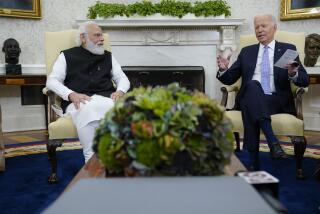PERSPECTIVE ON INDIA : The Social Contract Disintegrates : Unrest: South Asia is besieged by a breakdown of law and order, threatening the democratic states of the region.
- Share via
LAHORE, Pakistan — A terrifying siege is raging within much of South Asia. It is most evident in Pakistan, Bangladesh and Sri Lanka, which have been continuously racked by civil strife and crises of governance since they became independent.
But India was different. Or so we thought. Under Jawaharlal Nehru, India became a model of stable government, institutional development and planned economic growth. With his heirs, Indira Gandhi and Rajiv Gandhi, this process began to stall. The tragic assassination of Rajiv and the bloody violence that has gripped India in recent years are only the latest and most dramatic manifestations of this siege as it envelopes India.
This siege is characterized by an unrelenting breakdown of law and order. Rising ethnicity, casteism, sectarianism, regionalism and religious fundamentalism threaten to rip apart the secular, democratic, post-colonial state structures bequeathed by the founding fathers of most countries in the region, including India. The crisis of government throughout South Asia in fact suggests an ominous disintegration of the social contract between the rulers and the ruled, the state and society.
The social contract between state and society defines the basis of political association and public authority in modern times. It involves the citizen’s voluntary submission to the authority of the state in return for certain guarantees of life, liberty and the common good. Over time, it is expected to mature into a host of participatory institutions and social policies designed to ensure the welfare of the individual.
In countries like Pakistan and Bangladesh, the state has all but abandoned its citizens. Bouts of martial law, prohibitive defense expenditures, crumbling social infrastructures and the corruption and political opportunism of ruling elites have consciously sabotaged the social contract. Citizens have been forced to retreat into ideologies, sub-nationalisms and religions in order to fend for themselves. The state is unable or unwilling to provide employment, education, health, housing and transportation. As a consequence, the social psychology of the people of South Asia is characterized by insecurity, uncertainty and aggression.
The Indian state has become unduly ambitious over time. Under Indira Gandhi’s premiership, it sought to secure India as the fifth-largest power in the world. In consequence, beginning with India’s test-explosion of a nuclear device in 1974, there were several developments of far-reaching significance:
First, the collective leadership of the Congress-I Party was decimated to accommodate Indira Gandhi’s overriding ambitions. There was a rush to overly centralize the state in order to make it more powerful. Finally, the state was provided with the military hardware with which to flex its muscles and establish its political hegemony.
Inevitably, there were disagreeable repercussions. Dynastic tendencies were strengthened and the possibilities of alternative political leaderships were thwarted. The federal structure of India was brutally compromised by blatant interference in the affairs of several provincial governments, most notably in Punjab. India began to meddle with its neighbors, Pakistan to start with, followed by Bangladesh. There was little left of energy or resources to cope with the grinding demands of India’s burgeoning but insecure middle classes.
Under Rajiv Gandhi, the strife in East Punjab, Assam and elsewhere on the periphery of India, unleashed by his mother in the 1980s, was extended to include Kashmir and Tamil Nadu. Secularism was weakened for short-term political gains. Neighboring Sri Lanka and Nepal were alienated, while tensions with Pakistan and Bangladesh remained unresolved. The Indian military acquired a naval fleet to patrol the coastline from the Persian Gulf to East Africa. Indigenous missile technology was perfected, nuclear reactors were set up and the army was buttressed to nearly 50 divisions.
At the time of independence in 1947, Jawaharlal Nehru had referred to the unity and diversity of India as its enduring sources of strength. Under his dynastic successors, Indira and Rajiv, the wealth of Indian diversity was foolishly sacrificed at the alter of an illusive unity thrust from above. And the social contract between the federal government and the provinces of the union began to break down. The costly ambitions of the Indian state and the minimal requirements of the impoverished Indian masses for bread and shelter became increasingly incompatible.
The battered and bruised India that Rajiv Gandhi has left behind is a far cry from the stable, secular nation envisioned by his grandfather. Torn by militant Hinduism, soured by caste prejudices and threatened by violent separatism, the country is rudderless without the anchor of dynasty.
After such an auspicious start, is this great nation destined to fall by the political wayside in the fashion of its lesser neighbors? Or will the Indian people throw up a new leadership that is capable and willing to renew the social contract in all its necessary dimensions?
Writing a few years ago, an eminent Indian journalist, J. M. Akbar, drew attention to the developing “siege within.” Two decades ago, Selig Harrison of the Carnegie Institute for Peace Studies in Washington prophetically warned of the dangerous decades which lay ahead for the country. Rajiv Gandhi’s tragic death, even more than that of his mother some years ago, is an agonizing but urgent reminder that India can survive as a dynamic and modern nation only if its leaders consciously attempt to revive the forgotten pledge between the state and its subjects.
More to Read
Sign up for Essential California
The most important California stories and recommendations in your inbox every morning.
You may occasionally receive promotional content from the Los Angeles Times.













